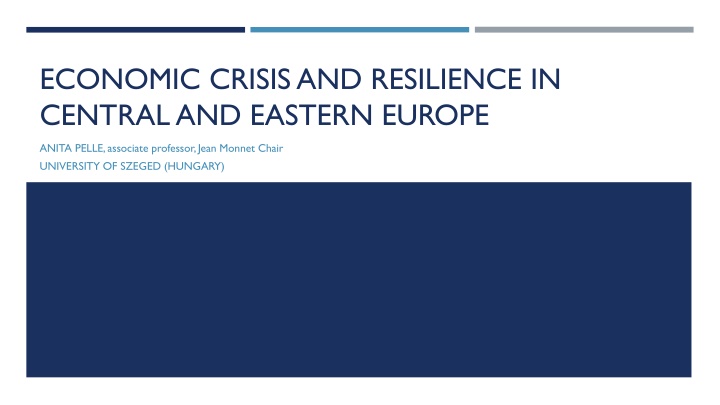
Economic Crisis and Resilience in Central and Eastern Europe
Explore the economic crisis and resilience in Central and Eastern Europe, focusing on post-crisis growth, employment trends, and government debt levels. Learn how countries in the region navigated through the crisis and their paths to recovery. Discover the competitive advantage of the CEECs and the impact of the crisis on their convergence process.
Download Presentation

Please find below an Image/Link to download the presentation.
The content on the website is provided AS IS for your information and personal use only. It may not be sold, licensed, or shared on other websites without obtaining consent from the author. If you encounter any issues during the download, it is possible that the publisher has removed the file from their server.
You are allowed to download the files provided on this website for personal or commercial use, subject to the condition that they are used lawfully. All files are the property of their respective owners.
The content on the website is provided AS IS for your information and personal use only. It may not be sold, licensed, or shared on other websites without obtaining consent from the author.
E N D
Presentation Transcript
ECONOMIC CRISIS AND RESILIENCE IN CENTRAL AND EASTERN EUROPE ANITA PELLE, associate professor, Jean Monnet Chair UNIVERSITY OF SZEGED (HUNGARY)
THE EU POST-CRISIS Growth returned in the EU and the Eurozone in 2013 GDP (at market prices, %, 2010=100) however, countries have followed different paths 120.0 110.0 Employment has been growing again as well since 2014 100.0 90.0 national varieties 80.0 Public finance situation is not favourable overall 1999 2016 2000 2001 2002 2003 2004 2005 2006 2007 2008 2009 2010 2011 2012 2013 2014 2015 2017 2018 debt stuck at high levels in some countries EU-28 EUR-19 Employment (in 1,000 persons, 2001Q1-2019Q1) Government debt, % of GDP, 2001-2018 225,000 95.0 220,000 85.0 215,000 210,000 75.0 205,000 65.0 200,000 55.0 195,000 190,000 EU-28 EUR-19 EU-28
GDP (AT MARKET PRICES, %, 2010=100) 140.0 Baltics: more or less a single track high improvement pre-crisis large fall-back due to crisis back on long-term path 130.0 120.0 110.0 100.0 90.0 80.0 70.0 60.0 19992000200120022003200420052006200720082009201020112012201320142015201620172018 Hungary Poland Romania Slovenia Slovakia 140.0 130.0 CEE: hit by crisis, back to growth path Slovenia had its own crisis Hungary: almost a decade lost 120.0 110.0 100.0 90.0 80.0 70.0 60.0 1999 2000 2001 2002 2003 2004 2005 2006 2007 2008 2009 2010 2011 2012 2013 2014 2015 2016 2017 2018 Estonia Latvia Lithuania
EMPLOYMENT (IN 1,000 PERSONS, 1999Q1-2019Q1) 5,200 17,000 5,000 16,000 4,800 15,000 4,600 14,000 4,400 13,000 12,000 4,200 11,000 4,000 10,000 3,800 9,000 3,600 8,000 3,400 7,000 1999Q1 1999Q3 2000Q1 2000Q3 2001Q1 2001Q3 2002Q1 2002Q3 2003Q1 2003Q3 2004Q1 2004Q3 2005Q1 2005Q3 2006Q1 2006Q3 2007Q1 2007Q3 2008Q1 2008Q3 2009Q1 2009Q3 2010Q1 2010Q3 2011Q1 2011Q3 2012Q1 2012Q3 2013Q1 2013Q3 2014Q1 2014Q3 2015Q1 2015Q3 2016Q1 2016Q3 2017Q1 2017Q3 2018Q1 2018Q3 2019Q1 Czechia Hungary Poland Romania CEE: each country going its own way Baltics: jobless growth (both before and since crisis) 1,500 1,300 1,100 900 700 500 1999Q1 1999Q3 2000Q1 2000Q3 2001Q1 2001Q3 2002Q1 2002Q3 2003Q1 2003Q3 2004Q1 2004Q3 2005Q1 2005Q3 2006Q1 2006Q3 2007Q1 2007Q3 2008Q1 2008Q3 2009Q1 2009Q3 2010Q1 2010Q3 2011Q1 2011Q3 2012Q1 2012Q3 2013Q1 2013Q3 2014Q1 2014Q3 2015Q1 2015Q3 2016Q1 2016Q3 2017Q1 2017Q3 2018Q1 2018Q3 2019Q1 Estonia Latvia Lithuania
THE COMPETITIVEADVANTAGE OF THE CEECs Until the crisis, the nature of CEECs competitive advantage lied mainly in the combination of: EU membership favourable geographical location (proximity to headquarters as well as markets) low wage for relatively high-skilled employees growth potential (sectoral, productivity, and national economic) with a developing business environment During the crisis: earlier convergence process stopped (Pelle et al. 2019) within-EU structural polarisation (Kapeller et al. 2019), CEECs semi-peripheral status consolidated (Farkas 2017)
THE INTRA-EU POST-CRISIS DIVIDE Post-crisis EU is divided into a core and a periphery Core: was highly resilient to the effects of the crisis advanced economies high value-added Periphery: Southern Eurozone and post-socialist new member states (NMS) countries hit hard by the crisis constrained into (Eurozone periphery) or opting for (NMS) cost competitveness Pelle, Anita (2017): The intra-EU migration challenge in the light of Kaldor s legacy. Acta Oeconomica, 67 (s1): 175-196.
RELATIVE POSITIONS OF EU MEMBER STATES POST-CRISIS -convergence in the EU, 1995-2017 (large figure), 2009-2017 (figure in figure) -convergence implies that countries initially less developed exhibit higher growth rates and thus there is upward convergence Regarding the full period (1995- 2017) there is -convergence in the EU, but post-crisis (2009-2017), there isn t Kuruczleki, va London, Andr s Pelle, Anita V gh, Marcell Z. (2019): Testing various European capitalism models: The case for growth, convergence, and responses to the crisis. WINIR Symposium Global Capitalism and Its National Varieties in an Era of Crisis, London, 16-18 Dec
THE CEE REGION HAS RECOVERED FROMTHE (PREVIOUS) CRISIS Czechia is currently at ca 90% of EU average Slovenia is back on track but earlier level of convergence not yet achieved HU, PL, SK: return to convergence after many years of stagnation due to crisis Romania surpassing Croatia Bulgaria: slow but steady convergence farthest from EU average GDP per capita in PPS (EU28=100) 100 90 80 70 60 50 40 30 2007 2008 2009 2010 2011 2012 2013 2014 2015 2016 2017 2018 Bulgaria Czechia Croatia Hungary Poland Romania Slovenia Slovakia BUT: CEECs "moving into the slow lane" (Astrov et al. 2019) from 2020 onwards Source: Eurostat [tec00114]
LONG-TERM LABOUR MARKET TRENDS IN CEE Shrinking working-age populations everywhere in the region largest rate of decline: Poland tipping points in the early or mid- 2020s To be only partly offset by positive net migration even in the most optimistic scenarios (Astrov 2019)
CURRENT STATE OF EUROPEAN ECONOMIC INTEGRATION The financial and economic crisis was a game changer for the EU and now COVID-19 is likely to be the next one Internal structure of the EU has changed considerably core-periphery divide persistent though core countries: enduring steady performance, coped well with the crisis Eurozone periphery: deteriorating performance, long-lasting negative effects of crisis Eastern new member states: crisis put a halt to earlier impressive convergence; diverse paths since then
THANKYOU FOR YOUR KINDATTENTION pelle@eco.u-szeged.hu









